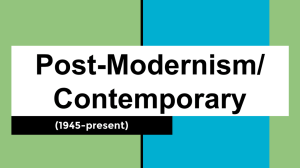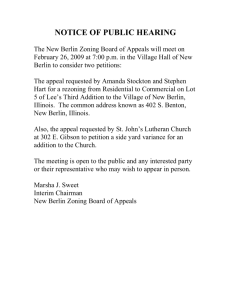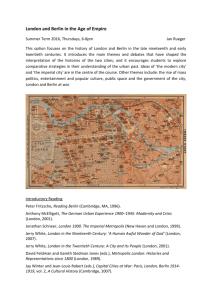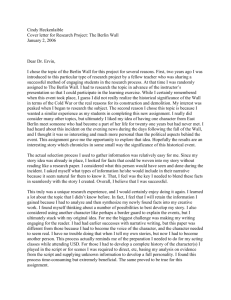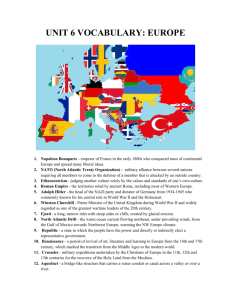joint mag Cities and People 16
advertisement
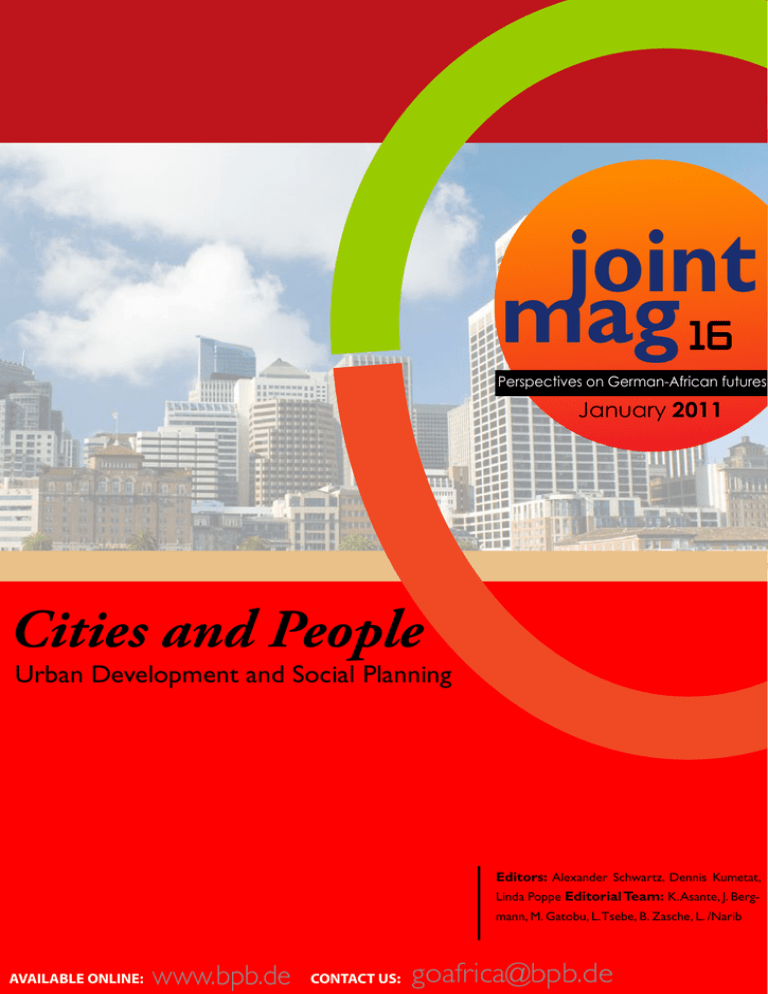
joint mag 16 Perspectives on German-African futures January 2011 Cities and People Urban Development and Social Planning Editors: Alexander Schwartz, Dennis Kumetat, Linda Poppe Editorial Team: K. Asante, J. Bergmann, M. Gatobu, L. Tsebe, B. Zasche, L. /Narib AVAILABLE ONLINE: www.bpb.de CONTACT US: goafrica@bpb.de ] in this issue 3 Editorial 4 Alumni Meeting Perspectives on German-African futures On the Way to partnerships European Normality ? 5 sustainable 7 Creating More Inclusive Cities 9 Alumni Profile Interview with Anna Acker THE JM TEAM ] joint mag 16 EDITORS: Alexander Schwartz, Dennis Kumetat, Linda Poppe // Editorial Team: K. Asante, J. Bergmann, M. Gatobu, L. Tsebe, B. Zasche LAYOUT & DESIGN: Leitago /Narib COVER PHOTOGRAPH: photoeverywhere.co.uk INSIDE PHOTOGRAPHS: Go Africa Go Germany Community We are on FACEBOOK Go Africa Go Germany goes facebook. If you “like”“Go Africa…Go Germany” and thus add it to your profile, you can follow the 4th generation on their upcoming trip to South Africa and meet former participants and those interested in the program. to go to our facebook page click here More than half of the world’s people live in cities. Reason enough to dedicate this issue to the question of urban development and social planning. Tracy Jooste, South Africa, gives us an update on the live and problems of city households in South Africa and Philip Böhm, Germany, describes the housing situation in Berlin. To put it in the words of alumnus Anna Acker: “It is time planners and architects (...) start building cities according to the requirements of their inhabitants.” EDITORIAL ] Dear Reader, Best, Your JointMAG Team PS: Don’t miss our bpb news and get involved! Alex Scwartz, Dennis Kumetat & Linda Poppe CALL Editors FOR CONTRIBUTIONS JM 18 - MIGRATION Well over 200 million people around the world, it is safe to estimate, will decide to or be forced to move to another country in 2011. These international migrants will be confronted by huge personal challenges and, in the countries of departure and destination as well as the international political arena, provoke intense discussions about the benefits, risks, and regulations of international migration. JM 18 will have a look at different parts of the big picture. Deadline for contributions is March 13th. CALL FOR PAPERS Go Africa…Go Germany 2011/12 The Federal Agency for Civic Education (Bundeszentrale für politische Bildung/bpb) is granting fellowships to students and young graduates, enabling them to take part in a five-week seminar to be held from 14th to 29th August 2011 in Germany and in March 2012 in Kenya. Full applications must be emailed to goafrica@bpb.de by 15 March 2011. More information can be found at http://bit.ly/ibKkdZ jm 3 joint mag ] JANUARY 2011 Alumni Meeting ))Kai Striebinger For some, the unique GAGG-experience has passed for quite a while. For others, the second part of the program will start in a few weeks. For everyone, the time is ripe to meet again. ni need to carry out a project? 3: Alumni Association As discussed at the last meet- ing and via email, we should set up our own alumni association during the meeting, pass a statute and Our next alumni meeting will take place at the end of elect a board. July near Cologne, Germany. Every former participant is invited to join, however, travel costs need to be covered on your own (e.g. by arranging scholarships). Your input is needed and wanted! All alumni – physically present at the meeting or not – can play a central role in planning the meeting and Please write to Josef (JosefHien(at)googlemail.com) the activities of the Go Africa…Go Germany net- or myself (KaiStriebinger(at)gmail.com) if you are interested in preparing the meeting, if you have experiwork. ence in the wide field of civic education, or if you are just curious and want to participate in preparing the The meeting in July will deal with three issues. meeting! 1: Civic education in a German-African context What is civic education? What does it mean in a German-African context? What are the tools of civic education? What are target groups for civic education? 2: Planning and running concrete (civic education) projects How is a project planned, conducted and evaluated? What tools and knowledge do we as alum- jm 4 joint mag ] JANUARY 2011 Berlin - On the Way to European normality ))Philip Böhm How the new housing situation in the central areas of western Berlin has become a social challenge. 90s). Most notably, in desperate need for manpower, thousands of Turkish immigrants were allured to the old workers’ districts of Wedding, Kreuzberg and In the last couple of years, Berlin has again become Neukölln. a gleaming capital, reconquering its role as a cosmopolitan city. Compared to other European capitals, But with the end of the Cold War the geographiBerlin also shows a favorable situation regarding the cal situation of these quarters changed within a few cost of everyday life and especially of its housing pric- months, as these formerly unattractive fringe areas es.We are still far away from Paris or London, where became central places within a reunited and changing living in the center has become a source of constant city. sorrow for the lower and middle class, which are ofIn the 1990s, change mostly affected areas in East ten forced to live in excluded suburbs. Berlin, leaving the former border areas with a reputaYet, it is a myth to believe that huge and affordable tion for youth crime and unrestrained political activapartments with rich decors can still be found in ism and the former communist districts inside the abundance. In reality, since the fall of the Wall in 1989, center, like Prenzlauerberg, with a period of house Berlin has been facing huge problems in managing its occupation due to large amounts of empty housing space. Today, districts like Prenzlauerberg have underquick urban and social development. gone further changes, witnessing the formation of a There was a time when the western part of the city new bourgeois area. was desperately searching for people who would live on this exposed island at the forefront of the Cold The constant redefinition and revaluation of the city War. Special advantages were given to West German center also hit the quarter of Kreuzberg and recentcitizens living in West Berlin. Men were, for instance, ly sloped to the neighboring parts of Neukölln, which exempted from obligatory military service (attract- is now subsequently known as „Kreuzkölln“, mixing ing numbers of „subversive elements“ who would up the two quarters’ names in former West Berlin. build the cities militant reputation in the 1980s and jm 5 joint mag ] JANUARY 2011 The housing situation is directly affected by this redefinition of the city. For people coming from Western Europe, the USA or even southern Germany, living in Neukölln can appear extremely inexpensive. Especially for those who „use“ the city for an undefined time and receive salaries above the Berlin average. They can make the city more interesting or colorful, however they are hitting the housing market with price expectations that do not fit the social reality of people who have lived and become established in Berlin for the last four decades. From the 16 category 1 Quatiersmangements in Berlin, 8 are in the tiny area of northern Neukölln (the part of Neukölln, which is situated within the city center). While the Quatiersmanagment includes social programs and efforts to re-embellish the city, the advantageous credits and aids that are provided for renovations are often abused by landlords (that tend more and more to be big real estate players) to raise rents or to maintain empty apartments for further speculations. As a result, many people are forced out of their quarter after the renovation of their houses, because they simply cannot afford the new rent. In a city, where 87% of the housing surface is rented and not owned, these changes have become a critical issue. The housing problems in Berlin are thus not only due to its attractiveness in Europe. It is mainly due to economic real estate strategies that are not sparing In West Berlin the average price per square meter Berlin and that influence political decision-making on is about 4,80 Euro with a tendency for exponential urban development. growth. From 2000 to 2007, Berlin already witnessed a 10% increase in rents. This does not yet include the “The Berlin housing market is on a clear path to Euannual 2.6 % increase in new renting contracts over ropean normality”, says politician Ludwig Burkardt. the last 10 years. The square meter price for a new Meanwhile, it seems that it is also sliding towards Eurent is now on average 5,8 Euro and can peak at 7,55 ropean normality with regards to social exclusion of the poorest groups too. Euro in Neukölln. In comparison to the average of 10,12 Euro a square meter in the city of Munich or 18,4 Euro in Paris, this seems low. But the income of the majority of the old inhabitants living in the affected quarters in Berlin is low, with almost half of them being unemployed. In Munich only 20% of a monthly income are used for paying rents; in Berlin it is 41%. The new developments in Berlin’s housing market lead to a situation, in which more and more people in Neukölln can no longer afford to pay the rents of the houses they used to live in. The city of Berlin has adopted an urban development strategy, that is very much aware of these changes known as “gentrification”. The City Council has established development strategies in small urban areas (sometimes containing just a few blocks) called Quartiersmanagement. Financed by city funds, the national government and the European Union, the development strategies concentrate on „socially problematic quarters“. These quarters are again divided in 4 categories - category 1 qualifies areas in which investments are the most intense. jm 6 joint mag ] JANUARY 2011 Philip Böhm Philip Böhm is a half French and half German student of journalism in Berlin. He has been living in Neukölln for the past four years, where he has experienced the rapid changes, which have affected his neighborhood. He is passionate about the multiple sides of the city, where he works as a tour guide in the historical center. South Africa Creating More Inclusive Cities An Overview of Trends in South Africa ))Tracy Jooste South Africa has experienced significant growth since the country became a democracy in 1994. Nowhere, this growth is more evident than in the country’s six metropolitan municipalities, namely the City of Johannesburg, City of Cape Town, City of Tshwane (Pretoria), Ethekwini (Durban), Nelson Mandela Bay (Port Elizabeth) and Ekhuruleni (East Rand). These cities are vibrant and diverse and represent major players in the country’s economy, contributing more than 50% to the country’s GDP in 2007. South Africa, the ‘Big 5 services’ are water, sanitation, electricity, solid waste removal and housing. Historically, service backlogs have been significant, but metropolitan municipalities have made huge investments since 1994; much of this targeted at poor households, with the government establishing specific grants for this purpose. The graph below shows changes in backlogs over time, comparing 2001 to 2007 (Source: National Consensus and Community Survey). As shown, backlogs have declined across all basic Statistics South Africa estimates that 17 million peo- services, with the exception of solid waste. Given the ple - nearly 40% of the country’s population - were lo- significant growth in population and thus demand cated across these six cities in 2007. On average, these for services over this same period, the results are encities have experienced a 15% growth in total popula- couraging. However, there remains much more to be tion between 2001 and 2007, largely due to significant done. The main backlogs which we face are with rerural-urban migration. Monitoring population growth spect to sanitation, where in 2007 an estimated 15% trends is particularly important from the perspec- of households were without access to either a flush tive of municipalities, since it is their responsibility to toilet or a ventilated pit latrine. Instead, they relied on provide services (such as water, sanitation, electricity either the use of a chemical, dry toilet or bucket for etc) to these households. South African municipali- sanitation. For electricity, 14% of households utilised ties have made significant infrastructure investments sources, such as paraffin or wood for lighting, in the to respond to the growing demand for services as a absence of either electricity or solar power. 11% of result of population increases. But addressing service households did not receive a kerbside waste collecdelivery needs is about much more than just a re- tion service and relied on either a communal dump or sponse to population growth. In the context of cities their own dumping site. In terms of water, the graph which have historically faced the uneven distribution Service backlogs in South Africa's Metros - 2001 and 2007 of municipal investments and services due the apart2001 2007 heid system of government - the system of racial seg19% 18% regation and political and economic discrimination 15% 14% against non-European groups implemented in the Re11% 10% public of South Africa by the National Party between 1948 and 1993 - the landscape is particularly unequal. 3% Progress in addressing basic service backlogs A primary step in the process of creating more inclusive cities entails addressing basic service backlogs. In jm 7 joint mag ] JANUARY 2011 2% % households with % households with % households with % households with inadequate inadequate inadequate solid inadequate water sanitation electricity waste removal Addressing the spatial aspects of inequality Most South African cities have been very progressive in ensuring that households receive free and/ or affordable access to basic services. However, even with full service access the urban poor face a particular challenge related to spatial inequality. Due in large part to apartheid urban planning, the poorest and most vulnerable sectors of sociWith respect to housing, estimates from 2007 sug- ety are typically located far from the city centres. gest that, on average, across these cities 13% of By implication they are geographically constrained households were located in informal settlements in terms of their access to jobs, educational institu(i.e. in shacks which form part of informal areas), tions, and social opportunities. Consequently, poor while 6% live in informal dwellings which are lo- households could spend between 10% and 25% of cated in the backyards of other dwellings, either their income on transport costs alone. formal or informal. One of the main challenges which cities face in addressing backlogs is the lack This creates a particular challenge for metropolitan of reliable data on the number of dwellings, partic- municipalities, most notably in terms of the proviularly in informal settlements and with respect to sion of public housing and public transport, and backyard dwellings. The lack of reliable data makes speaks to a broader need to create more integrated planning and financial budgeting particularly dif- cities. In terms of housing, the challenge is to find ficult and a number of cities, such as the City of Jo- sufficient vacant land that is affordable and located burg, have recently conducted studies specifically nearer to the city. Given the rate of urban development taking place, this is not always possible. aimed at providing more accurate data. Creating more integrated public transport systems therefore becomes very important. The challenge Free basic service provision Providing the infrastructure to support new service for municipalities is to offer a range of public transconnections is only one aspect of creating more in- port systems which are affordable, efficient and clusive cities. In order to ensure poor households safe for commuters. have sustainable access, most metropolitan municipalities have comprehensive social packages, Progress in this regard includes the introduction of which allow for access to free basic services. Typi- Bus Rapid Transport systems in the cities of Johancally, households classified poor (the criteria for nesburg and Cape Town. With respect to housing, ‘poor’ differ somewhat between municipalities, but municipalities have forged partnerships with other generally a household income threshold is used), spheres of government to provide a broader specwould receive free access to a capped level of ser- trum of housing options to the poor, for example vice. The City of Cape Town for example provides rental housing units, that tend to be located nearer every household (regardless of income) with a free the city. allocation of 6000 litres of water per month and grants poor households, that are registered as indi- Metropolitan municipalities have displayed a gent with an additional free allocation of 4500 litres strong commitment towards improving the lives of of water per month. Free basic allowances are also the urban poor and addressing inequality remains made for electricity, sanitation, and solid waste re- high on the urban agenda. While there are signifimoval in all six metropolitan municipalities. Public cant challenges to overcome, recent trends and housing is provided through a housing subsidy, a developments indicate that South African cities are grant received from the national government, to actively responding to the needs of the poor and eligible citizens with an income of less than R3, 500 moving closer towards becoming more inclusive. per month. shows that in 2007, 2% of households were obtaining water from a source (such as a communal standpipe) that was more than 200 metres from their dwelling. While these backlogs are not significant in percentage terms, the numbers of poor urban households that still rely on less than adequate services remains a challenge. jm 8 joint mag ] JANUARY 2011 ALUMNI PROFILE Interview with Anna Acker JM: Hi Anna! Can you tell us a little bit about yourself? ANNA: Sure! I was lucky enough to be part in the Birim South District in the Eastern Region of Ghana. This specific project, with the Ghanaian NGO CAYDNET entailed the construction of a skills training and processing centre, in which young people with of the legendary 1st Generation Matsatsansa crowd disabilities can acquire skills to make profitable local travelling Germany and Namibia in 2007. It was an incrafts (such as soap, pomade and batik) and thereby credible time and I will be eternally grateful for this become equipped to earn an independent income. experience. I have become interested in African politics and development questions early on as a pimply teenager, when living in my friend’s family’s household. They had just returned from five years living and working in a Tanzanian village and planted ideas of fair trade, ujamaa and the evil Bretton Woods Institutions in my mind. Since then my ideas and passions have been somewhat refined and I have come to cultivate a strong love-hate relationship with International Development. JM:… and Ethiopia? ANNA: Following this grass-roots level expe- rience I was keen to explore the policy level of international development. I managed to secure a shortterm consultancy and internship in Addis Ababa. I was working for the GTZ Urban Governance and Decentralisation Programme, being responsible for analysing the results of their programme’s monitoring and evaluation survey in 18 Ethiopian cities. Furthermore, we were working on an e-learning strategy for public servants in municipal finance. The most interesting I have studied Politics and Economics at the Univer- part was researching new possibilities of cooperation sity of Edinburgh. After having volunteered/worked/ between GTZ and the Ethiopian Civil Service College. lived in Rwanda, Tanzania, Ghana and Ethiopia I am now back in the U.K. I am currently doing a Masters in Urbanisation and Development at the London School This issue of JointMAG deals with urban develof Economics. opment and planning. How have you become inter- JM: JM: After Go Afria... Go Germany, you were getting ested in this topic? ANNA: Yes, during my last year at university by various impressions and insights of living in different cities such as Addis Ababa, Berlin, Edinburgh, Dar-es- Salaam or Kigali. It became quickly obvious that most social issues and spatial inequalities are a running thread through most cities and I became very intrigued. I am not interested in technical planning – I am leaving this to the architects. I focus on the social and political aspects of city planning and development and have become especially interested ready to go to Ghana. I was selected as coordinator for a project in Ghana with Edinburgh Global Partnerships (EGP), a studentrun, non-profit charity organisation. EGP carries out small-scale, sustainable development projects in Africa, Asia and South America annually. I was responsible for training and guiding a team of volunteers and for fundraising the budget of the 2008 project jm 9 joint mag ] JANUARY 2011 ANNA: I think it was a gradual process shaped in housing issues, the dynamics of formal and infor- natural and man-made hazards and can rarely exmal urban labour markets and the socio-political ercise their right to the city. Social and spatial inequalities within cities are enormous and may ulimpacts of mega-events on cities. timately lead to conflict or breakdown. This is why Cities in Africa and Europe - which trends will we cities need to be planned and developed in an insee in the next few decades and which do you think clusive, socially and environmentally sustainable way. To put it in Ban Ki-Moon’s words: cities need to will be the biggest challenges? be built to last and built to serve. It is time planners There is no easy answer to this question and the and architects dispense the long-practiced focus on answer will clearly vary depending on whether you aesthetics and start building cities according to the ask an architect or planner, an urban economist or requirements of their inhabitants. an urban sociologist. Cities are mirrors of very comThanks Anna. One last question: What are your plex realities and despite certain commonalities, it remains difficult to generalise. In my opinion one of future plans? the key challenges will be to create greener, enerFor now I am just focussed on passgy-efficient cities adapted to the impacts of climate ing my exams this summer and on writing my disserchange. tation. There is a jungle of opportunities after gradHowever, it is crucial to go beyond this focus on uation and I am finding it difficult to decide. Many building environmentally sustainable cities and to people in my course go on to work for international tackle the true Herculean task: to make cities social- development organisations. I am interested in that but I am considering staying in London for a while, ly sustainable. either working for a development think tank or an NGO. Potentially I would like to get involved with What do you mean by socially sustainable? planning the legacy of the 2012 Olympics. Also, I The majority of today’s world popu- am quite interested in the work of COHRE (Center lation lives in cities and this poses unprecedented on Housing Rights and Evictions). So I might come challenges to local governments and planners. Vast and join the Southern African Matsatsansa crowd parts of the urban population live in questionable and work in South Africa for a while. JM: ANNA: JM: ANNA: conditions with limited or no access to formal housing, land and services. They are most vulnerable to jm 10 joint mag ] JANUARY 2011 joint mag Perspectives on German-African futures Website: www.bpb.de e-mail address: goafrica@bpb.de we are on facebook: Go Africa Go Germany Facebook
